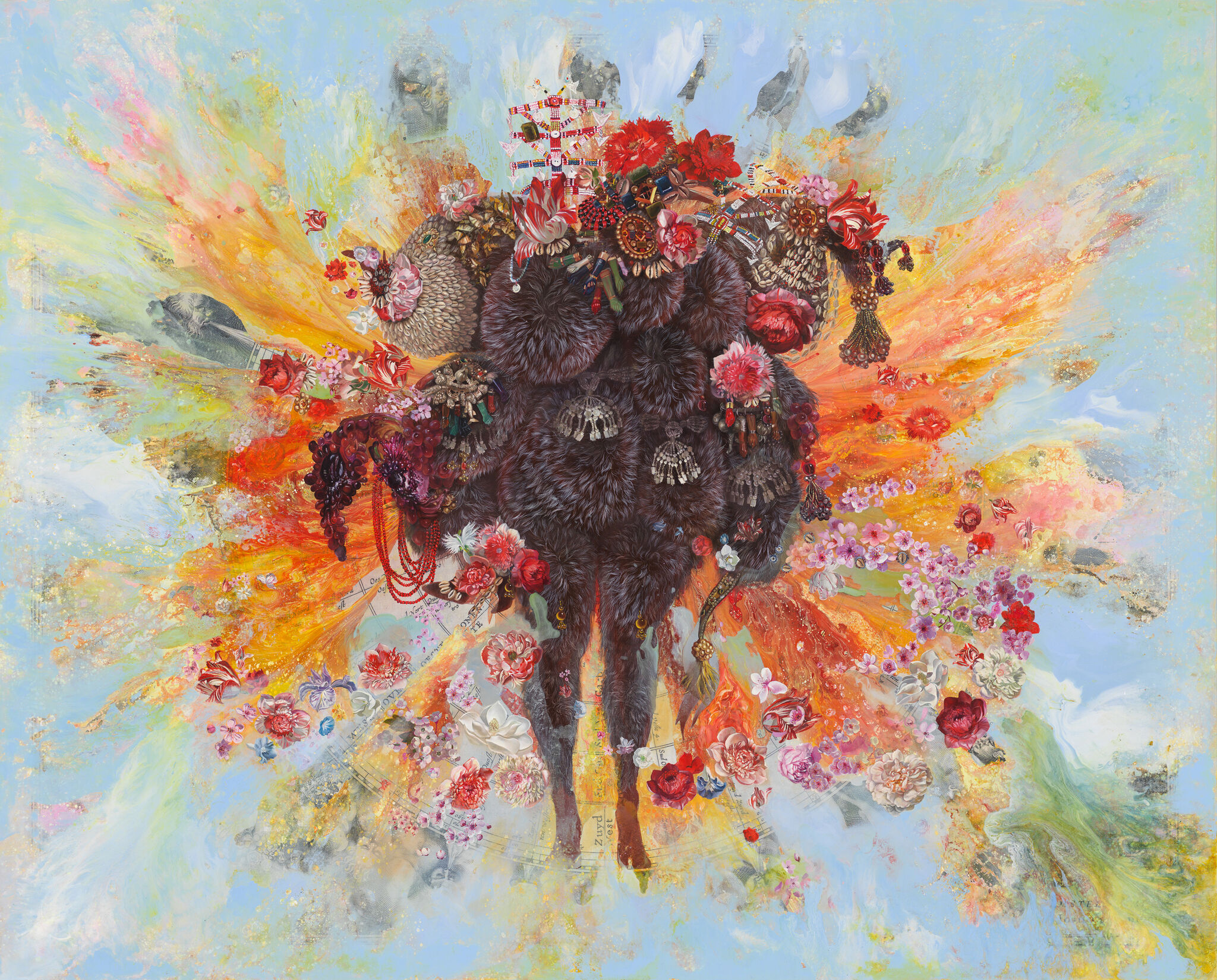Shifting Landscapes | Art & Artists
Another World
7
These works propose an alternative geography where humans, animals, and nature inhabit one another. Mundo Meza’s painting of a brawny merman reclining on a mandolin and rafa esparza’s portrait of himself embedded in the land exemplify how some artists are attempting to decenter an anthropocentric worldview by rejecting any traces of an identifiable landscape that could point to a particular nationalist agenda, cultural context, or even heteronormative conception of humanity. In other artworks, such as Dalton Gata’s painting of a blonde character with her mane ablaze, artists include shape-shifting figures that appear in fellowship with their environment. Their works gesture toward ways of resisting hierarchical structures of power that advance new forms of envisioning the future and the beings that populate it.
Firelei Báez
Untitled (Tabula Anemographica seu Pyxis Navtic), 2021
In Firelei Báez’s painting Untitled (Tabula Anemographica seu Pyxis Navtic), a furry brown body with hooves for feet and eyes at knee-level erupts from the center of the composition decorated in an assortment of flowers, beaded headdresses, and cowrie shells. A trickster creature from Dominican folklore with roots in Taíno mythology, the ciguapa is superimposed atop a barely visible old cartographic document: one of the earliest and most significant wind rose charts (or anemographs) from the seventeenth century. Functional navigational tools at one point in history, charts like this one trafficked in stereotypes; each wind was personified using a head of a figure bearing the racial characteristics associated with the region or direction represented. The ciguapa, however, rejects these Western methods of pictorializing knowledge by asserting her larger-than-life body as the originator of a new mapping system for a fictional alternative universe.
Learn about the trickster figure in this work, the ciguapa.
Artists
- Robert Adams
- Yuji Agematsu
- Laura Aguilar
- John Ahearn
- Felipe Baeza
- Firelei Báez
- Melvonna Ballenger
- Orian Barki
- Jean-Michel Basquiat
- Meriem Bennani
- María Berrío
- Diane Burns
- Jenny Calivas
- Carolina Caycedo
- Enrique Chagoya
- Tseng Kwong Chi
- Arch Connelly
- Agnes Denes
- Jane Dickson
- Chioma Ebinama
- rafa esparza
- Christina Fernandez
- Teresita Fernández
- Steven Fragale
- LaToya Ruby Frazier
- Dalton Gata
- Aaron Gilbert
- Martine Gutierrez
- Keith Haring
- Bessie Harvey
- Lonnie Holley
- Nancy Holt
- Pao Houa Her
- Donna Huanca
- Peter Hujar
- Suzanne Jackson
- Ulysses Jenkins
- Luis Jimenez
- Michael Joo
- Sonya Kelliher-Combs
- An-My Lê
- Maya Lin
- Miguel Luciano
- James Luna
- Guadalupe Maravilla
- Hiram Maristany
- Leslie Martinez
- Patrick Martinez
- Gordon Matta-Clark
- Keith Mayerson
- Park McArthur
- Ana Mendieta
- Amalia Mesa-Bains
- Mundo Meza
- Alan Michelson
- Troy Michie
- Joe Minter
- Kenji Nakahashi
- Martha Jane Pettway
- Piliāmo‘o
- Piliāmo'o
- Chuck Ramirez
- Sophie Rivera
- Alison Saar
- David Benjamin Sherry
- Trevor Shimizu
- Nicole Soto Rodríguez
- Anita Steckel
- Michelle Stuart
- Kunié Sugiura
- Tabboo!
- Salman Toor
- Rigoberto Torres
- Theo Triantafyllidis
- Artie Vierkant
- Carlos Villa
- Emmi Whitehorse
- Martin Wong
- Purvis Young

